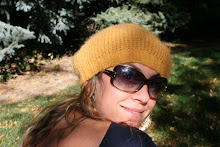One boy accidentally discovered that he could, "make thin lines using thick lines". He was drawing with a ball point pen on white paper atop a drawing mat (which provides a slight cushion). He then turned the paper over and exchanged the pen for a charcoal pencil, experimenting with thick black lines. The charcoal residue began to adhere to the impression of his drawing from the reverse side of the paper. Without a word, he quickly grabbed the black crayon and rubbed the surface of the imprint. He looked at his work amazed and brought it to me. I in turn expressed my interest in his process and he demonstrated his findings to everyone gathered at the table. We were all excited by his discovery and soon several students were independently exploring his technique, with his guidance wherever needed. He was visibly satisfied by this opportunity to share with his classmates.
 Later, I asked another group of students if they could think of some work in their classroom that was really long. We came up with lots of great ideas and then I offered a possible hint, "Is there something long and red in your classroom?". A unanimous chorus of "the red rods" sounded and two eager students hurried off to retrieve the longest red rod and the shortest red rod. (For anyone unfamiliar with either the red rods or the broad stair, they are standard Montessori sensorial materials that isolate length and width respectively).
Later, I asked another group of students if they could think of some work in their classroom that was really long. We came up with lots of great ideas and then I offered a possible hint, "Is there something long and red in your classroom?". A unanimous chorus of "the red rods" sounded and two eager students hurried off to retrieve the longest red rod and the shortest red rod. (For anyone unfamiliar with either the red rods or the broad stair, they are standard Montessori sensorial materials that isolate length and width respectively). After exploring and comparing the longest rod and the shortest rod, I asked if anyone was interested in trying to draw lines that are long or short. It would be an understatement to say that the students were eager. They were positively passionate about these materials which many of them began using more than two years ago. Several students decided to trace the rods and then fill in the long rectangular shape that resulted.
After exploring and comparing the longest rod and the shortest rod, I asked if anyone was interested in trying to draw lines that are long or short. It would be an understatement to say that the students were eager. They were positively passionate about these materials which many of them began using more than two years ago. Several students decided to trace the rods and then fill in the long rectangular shape that resulted. Another student chose to begin tracing each of the red rods on paper. At one point he called the second red rod "the two rod", with an obvious understanding of the similarity between the red rods and the number rods in his classroom.
Another student chose to begin tracing each of the red rods on paper. At one point he called the second red rod "the two rod", with an obvious understanding of the similarity between the red rods and the number rods in his classroom.
This student, pictured below, began by tracing the shortest rod, but quickly progressed to filling in the drawn shape and elongating it into a bat, "a thick line". He then drew "thin lines" to create a baseball. Beneath the image he began carefully and deliberately to draw a scoreboard. This process fascinated him and after some effort, he glanced up and announced, "I'm making a pattern" and he was!
 Another child chose to make one long, rambling line paired with a host of small dots.
Another child chose to make one long, rambling line paired with a host of small dots. Several students commented on emerging patterns in their work. This student was making a color pattern.
Several students commented on emerging patterns in their work. This student was making a color pattern.  After a brief conversation with the XP teachers, I discovered that they have been discussing pattern in class and how line can be repetitive. This could be a good studio exploration for another day.
After a brief conversation with the XP teachers, I discovered that they have been discussing pattern in class and how line can be repetitive. This could be a good studio exploration for another day. 
No comments:
Post a Comment